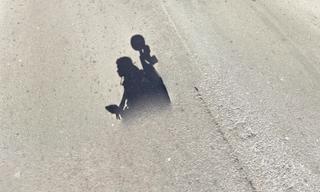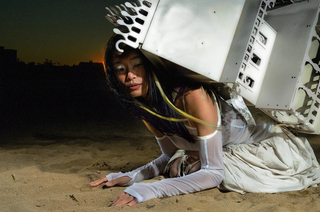

every time we touch I get this feeling
Felix Ashford, Paul Boyé & Ella Valentine Bunker, Kalanjay Dhir, Eugene Hawkins, Lucas Horta, Henry Lai-Pyne (eek), Jake Starr, Yanti Peng
28 Aug–21 Sep 2024
What started out as an exhibition around the idea of astroturfing – think: fake crowds, crisis actors, stand-ins, psy-ops, AI girlfriends – moved more and more (back) towards the screenic – think: avatars, anons, doom scrolls, core core, portrait-mode ways-of-seeing. The tether towards the screen is unyielding. every time we touch I get this feeling. The Screenic, al la Philip Brophy, is a liquid framework of media (iphones, video art [must not be boring], youtube, liveleak, VR, hollywood movies) is fundamentally porous and intersected with politics and culture. We watch videos of war on the same devices we use to text each other, slide into dms, watch puppet-making tutorials, troll anonymous forums, send reels, read substacks, capture the world. boring ahhh, exhibition text. The liberty to swipe and skip – tracing our finger, smudging the screen, feeling and indexing our way. We find ourselves incredibly fastened to the screenic, an eleventh finger, a third eye, a cloned voice. But always paradoxically at an ‘epistemic distance, aesthetic distance, and ontological distance’. A lag, time buffers – a small rupture that pulls our attention outwards. You reach out your fingers to run them across the tall grass but it’s astroturf. You watch a video of rocks being re-hydrated. An invisible network of actors, coordinated agents, fingers caught in the margins of scans. Closed circuit loops. The works found here are bioluminescent – a soft blue light drawing us closer, as we run our fingers across the surface, it sparks and slowly washes over us. every time we touch I get this feeling brings together local artists from Naarm/Melbourne, Warrang/Sydney, Boorloo/Perth, and London-via-Sydney, who all engage in these ideas in playful, critical, and differential ways. Basically, I fw them all heavy. UwU.
























This exhibition began with the idea of astroturfing – fake crowds, crisis actors, stand-ins, psy-ops, and AI girlfriends. But it gradually shifted back towards screen-related concepts – avatars, anons, doom scrolling, portrait-mode viewing.
We use the same devices to watch war videos, text, watch tutorials, join anonymous forums – constantly interact with screens, tracing our fingers, smudging them, and navigating through content quickly. Like an extra finger, a third eye, or a cloned voice.
This exhibition brings together local artists from Naarm/Melbourne, Warrang/Sydney, Boorloo/Perth, and London-via-Sydney, who explore these ideas in creative, critical, and different ways.
This program takes place on the land of the Wurundjeri people of the Kulin Nation. We recognise that sovereignty was never ceded - this land is stolen land. We pay respects to Wurundjeri Elders, past, present and emerging, to the Elders from other communities and to any other Aboriginal or Torres Strait Islanders who might encounter or participate in the program.
Felix Ashford is a curator, writer, and artist who explores the gallery as a potential site of (re)activation through ritual, previously based in Sydney, he now lives in London. Informed by a Bachelors in Visual Art and Studies in Religion at the University of Sydney, his research centers around post-digital sacrality, museology, neo-medievalism, and Hierotopy. In his curatorial practice, Ashford often incorporates performance, sound, lighting, and hardware to construct totalised numinous environments. In 2022, Ashford co-founded the off-site platform Ritual Transmission Agency. These nomadic exhibitions have since taken place at various locations, from a 12th century fortress in Carcassonne to an abandoned nightclub in Kings Cross.
Paul Boyé & Ella Valentine BunkerPaul Boyé is a writer based in Boorloo/Perth, interested in the pathos of emerging social technologies.
Ella Valentine, also based in Boorloo, is an artist working from their studio at Light Works.
Paul and Ella work collaboratively on text, video, material and performance works mostly driven by each other’s habitual online consumption and production.
Kalanjay Dhir is an artist and musician based in Sydney on unceded Dharug land. His work draws on popular culture, sci-fi and history, using sculpture and video. Kalanjay likes to make up near-future worlds that imagine hopeful ways humans could relate to their environment. He enjoys thinking about the imprint that terrestrial human consciousness will leave on the earth and surrounding cosmos.
Eugene Hawkins is a writer and recovering internet harvester.
Lucas Horta is a digital artist based in Naarm (Melbourne), originally from Kaurna Land (Adelaide). His work is informed by deep dives and readings in digital culture, wandering around, gleaning articles and epubs to reflect through. Lucas uses 3d modelling, code, game engines and photogrammetry to create narratives across digital mediums.
Henry Lai-Pyne (eek)Henry Lai-Pyne aka Eek is a Naarm/Melbourne based new-media artist working across moving image, live multi-media performance, game design, and broadcasting. His work centres relations between the human and screen-focused technology and media.
Henry’s individual and collaborative work has been featured at MoNA, Soft Centre (Eora/Sydney), 4A Centre for Contemporary Asian Art, ACMI, Liquid Architecture, Arts House, AsiaTOPA, and AIDLAB Hong Kong.
Jake Starr is a transdisciplinary artist residing on Gadigal land/Sydney. Their work occupies the realms of new media, sculpture, writing and photography. Starr’s practice engages with new technologies, non-anthropocentric theory and a diverse lineage of image making processes to generate future imaginaries as a means of critiquing the trajectory of anthropocentric techno-capitalism. Much of their practice involves the collation and expropriation of overlooked data. The process of image making allows Starr to visually reify the glitches, contradictions and ideological undercurrents of data sets, illuminating the material realities of abstracted information while theorising on the future implications of our technological and ideological systems.
Yanti Peng, 彭妍缇, is a Hainanese-"Australian" anti-disciplinary designer and artist working across new media, photography, and 3D computer tools. Her works explore community, technology, and identity. Often imbuing humour in her making, she intersects disciplines like puzzles to piece together new ways to stage her observations, research, and ideas.
Audrey Jo Pfister writes, edits, curates and works in the arts. Audrey is a recent resident of Naarm, and working as the un Projects General Manager. Audrey has a Bachelor of Art Theory and First Class Honours in Arts (Media, Culture, Technology) from UNSW. They have worked previously as the Kudos Coordinator, Framework Editor-in-Chief, and was a previous board member at Runway Journal. Audrey has written for Memo, Running Dog, and Overland, and has curated for Kudos Gallery, Prop, Cement Fondu, and Gaffa.












